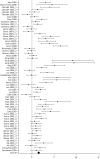Ischemic preconditioning in the animal kidney, a systematic review and meta-analysis
- PMID: 22389693
- PMCID: PMC3289650
- DOI: 10.1371/journal.pone.0032296
Ischemic preconditioning in the animal kidney, a systematic review and meta-analysis
Abstract
Ischemic preconditioning (IPC) is a potent renoprotective strategy which has not yet been translated successfully into clinical practice, in spite of promising results in animal studies. We performed a unique systematic review and meta-analysis of animal studies to identify factors modifying IPC efficacy in renal ischemia/reperfusion injury (IRI), in order to enhance the design of future (clinical) studies. An electronic literature search for animal studies on IPC in renal IRI yielded fifty-eight studies which met our inclusion criteria. We extracted data for serum creatinine, blood urea nitrogen and histological renal damage, as well as study quality indicators. Meta-analysis showed that IPC reduces serum creatinine (SMD 1.54 [95%CI 1.16, 1.93]), blood urea nitrogen (SMD 1.42 [95% CI 0.97, 1.87]) and histological renal damage (SMD 1.12 [95% CI 0.89, 1.35]) after IRI as compared to controls. Factors influencing IPC efficacy were the window of protection (<24 h = early vs. ≥ 24 h = late) and animal species (rat vs. mouse). No difference in efficacy between local and remote IPC was observed. In conclusion, our findings show that IPC effectively reduces renal damage after IRI, with higher efficacy in the late window of protection. However, there is a large gap in study data concerning the optimal window of protection, and IPC efficacy may differ per animal species. Moreover, current clinical trials on RIPC may not be optimally designed, and our findings identify a need for further standardization of animal experiments.
Conflict of interest statement
Figures





References
-
- Yin DP, Sankary HN, Chong AS, Ma LL, Shen J, et al. Protective effect of ischemic preconditioning on liver preservation-reperfusion injury in rats. Transplantation. 1998;66:152–157. - PubMed
-
- Hausenloy DJ, Yellon DM. Preconditioning and postconditioning: underlying mechanisms and clinical application. Atherosclerosis. 2009;204:334–341. doi: 10.1016/j.atherosclerosis.2008.10.029. - DOI - PubMed
-
- Chen X, Liu X, Wan X, Wu Y, Chen Y, et al. Ischemic preconditioning attenuates renal ischemia-reperfusion injury by inhibiting activation of IKKbeta and inflammatory response. Am J Nephrol. 2009;30:287–294. doi: 10.1159/000225928. - DOI - PubMed
-
- Murry CE, Jennings RB, Reimer KA. Preconditioning with ischemia: a delay of lethal cell injury in ischemic myocardium. Circulation. 1986;74:1124–1136. - PubMed
-
- Przyklenk K, Bauer B, Ovize M, Kloner RA, Whittaker P. Regional ischemic “preconditioning” protects remote virgin myocardium from subsequent sustained coronary occlusion. Circulation. 1993;87:893–899. - PubMed
Publication types
MeSH terms
Substances
LinkOut - more resources
Full Text Sources
Miscellaneous

